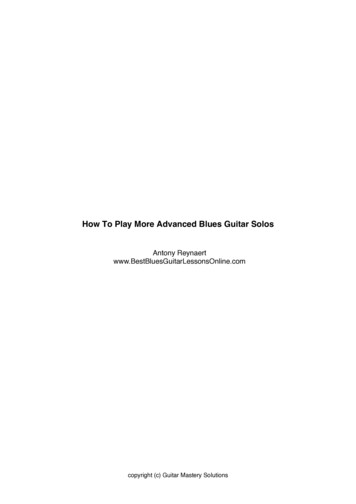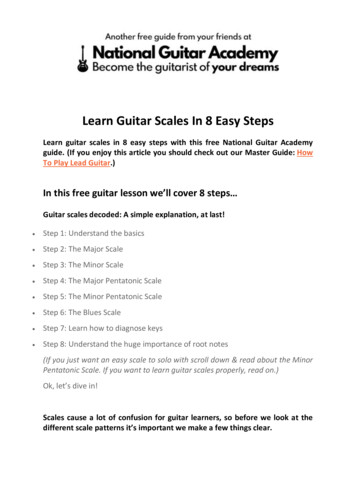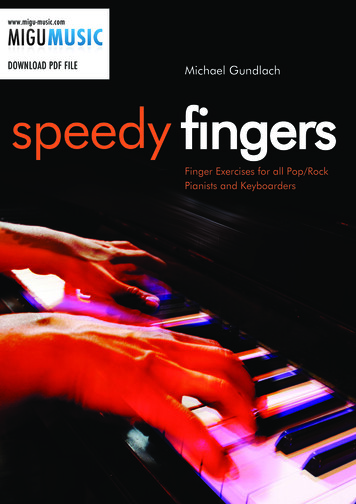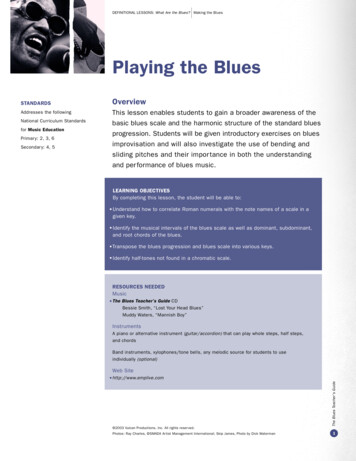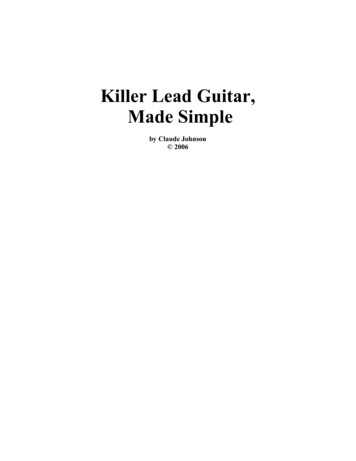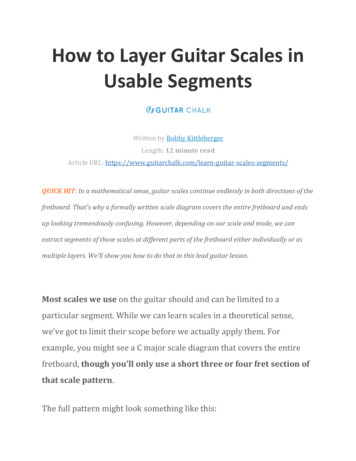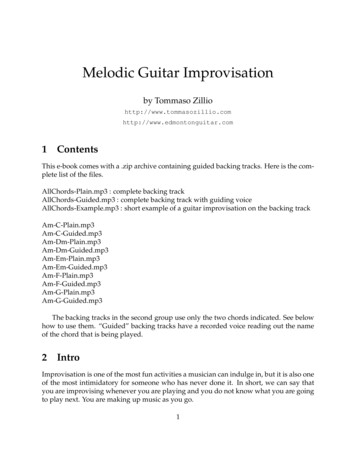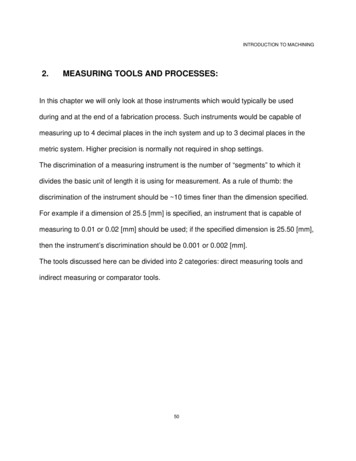
Transcription
Pentatonic ScaleStudiesSecond Edition (2003)Edward PetersenRoving Bovine Music
Pentatonic ScaleStudiesSecond EditionMany thanks to Brian Seeger for his work in repairing and organizingthe Pentatonic Scale Compendium and for his many other contributionsto my music education.Copyright 2003 by Edward PetersenRoving Bovine MusicASCAP
Table of ContentsIntroduction 1The Scales1.1 Pentatonic Scale Compendium 1 91.2 Pentatonic Scale Compendium 2.171.3 Selected Pentatonic Scales-Suggested Harmonic Applications.25Shapes (Pentatonic 326)2.1 Getting Familiar with the Intervals.292.2 Intervallic Scale Studies.322.3 Four Note Patterns.382.4 Three Note Patterns 592.5 More Shapes 67Shapes (Pentatonic 305)3.1 Getting Familiar with the Intervals.733.2 Intervallic Scale Studies.763.3 Four Note Patterns.823.4 Three Note Patterns 1033.5 More Shapes 111Coda4.1 Shape Morphing 1174.2 “Intervallistics” 1214.3 Pentatonic Shapes Over Changes 1264.4 Pent-Up Stella 129
IntroductionThis book is intended to serve as a point of departure for the study of pentatonicscales. It looks like a method book and can be used as one, but it is better to thinkof it as a collection of potentially useful intervallic sequences*1 that are designedto be modified to suit the player’s (your) purposes. I use the phrase “potentiallyuseful” because they will be of little benefit until you have developed your ownway of understanding them and using them in the creation of your music.There are many pentatonic scales. The Pentatonic Scale Compendia found insection one list all three hundred thirty pentatonic scales*2 that contain the note“C.” The best way to learn them is to choose one scale that appeals to you andspend a considerable amount of time and energy practicing and thinking of waysin which you can use it before exploring other scales. Become familiar with theintervallic patterns that characterize the scale. The exercises in Section 2.1 (Page29) are studies in the movement of every note in a scale to every other note,throughout the range of your instrument. They are notated within the practicalwritten range of the saxophone, but please decrease or increase the range to fityour instrument. If you have chosen a scale other than the one that is used inthese exercises (which is number three hundred twenty six*3 in the PentatonicScale Compendium, often referred to as the “Major (326) or Minor (330)Pentatonic Scale”*4), play the shapes found in the exercises, but replace thewritten notes with the notes of your chosen scale. Once you are familiar with theintervallic characteristics of the scale, it should be very easy to play in any key.Do this by using your musicianship and feeling, not your muscle memory ormathematical transposition skills. Every pattern in this book is based on “C.” Itis essential to play the scales and other shapes that interest you in every key. If Ihad wasted the paper necessary to notate these “transpositions,” you and I, asusers of this book, would not be well-served. It is much more beneficial for us todevelop the ability to imagine and then play musical gestures at various pitchlevels than it is to read notes that provide directions on the proper buttons topush.
In addition to developing familiarity with the melodic interaction of the notes inthe scale, it is important to understand their relationship to various harmonicconfigurations. Some pentatonic scales contain so many contiguous smallintervals that it is difficult to discern a strong relationship with most“mainstream” harmonies, but they may relate very clearly to certaincontemporary “outside” or “cluster” harmonies. Many other pentatonics can beused to create music that relates very clearly to “mainstream” harmonies. Forexample, Pentatonic 326 is comprised of a major second, another major second, aminor third, another major second, and another minor third. Starting on “C,”that is the following notes: C, D, E, G, and A. Please consider these notes in thefollowing harmonic contexts:In relation to a:* CMaj7 or C7 chord this scale contains the root, ninth, third, fifth, thirteenth(sixth)* D7(sus4) seventh, root, ninth, (suspended) fourth, fifth* E Phrygian (F/E) minor thirteenth (minor sixth) or augmented fifth, seventh,root, (minor) third, eleventh* F Maj7 fifth, thirteenth, seventh, ninth, third,* F#7( 5 9) or F#7( 5 -9) aka F#7alt. augmented eleventh, augmented fifth,seventh, minor ninth, augmented ninth* Gmin7 or G7(sus4) fourth, fifth, thirteenth, root, ninth* Amin7 or A Phrygian third, fourth, fifth, seventh* BbMaj7 chord ninth, third, augmented eleventh, thirteenth, seventhAll of the above examples demonstrate the use of these notes as components ofthe designated chords. The scale can be used very effectively in other ways, too.For example, in relation to an Abmin7 chord, this useful pentatonic contains all ofthe notes that are “outside” of the chord and the scale that is usually associatedwith it, the Ab Dorian scale. In other words, Pentatonic 326 contains all of thechromatic notes in relationship to this chord/scale sound! Familiarity with thisvery convenient way of organizing diatonic and chromatic elements can be veryliberating for the improviser.After you have found a scale/interval set that you like and become familiar with2
its characteristics and possible harmonic applications, look at some of the otherexercises in Section 2. You will find a vast number of melodic shapes that areconstructed from a pentatonic scale (326). You can read these in the way that youwould read the pages of a method book, but you can learn more and have morefun by doing the following:1) Find one shape, or melodic gesture that appeals to you2) Identify the intervallic characteristics3) “Plug-in” the notes of your selected scale. In other words, replace thewritten notes with notes from the scale that you are practicing, while retainingthe shape of the written phrase4) Play your version of the shape in every key throughout the full range ofyour instrument5) Explore rhythmic and metrical variations. If the phrase is in 2/4,experiment with techniques for playing it in 3/4 or 5/4 or? This can beaccomplished by adding or deleting notes or rests or by changing durations6) Play your new variations in every key throughout the full range of yourinstrument7) “Plug-in” other scales. Retain the shape of the gesture, but replace thenotes with notes from other pentatonic, diatonic, diminished, augmented, orother scales/interval sets.8) Play your new variations in every key throughout the full range of yourinstrument9) Try to play your shape over a set of chord changes. Change thecomponent scales and make the corresponding adjustments to your shape inresponse to the changes in the harmony (Please see example on page 126)10) See how far you can bend the gesture until it becomes somethingelse if you like your new creation, forget about this book and continue toexplore your new phrase! This type of practice develops the ability to thinkcompositionally, while improving technique and aural skills. It will cultivatebetter understanding of the ways in which musical gestures can evolve and serveas the basis for the creation of new expressions. It improves our ability to finetune musical ideas so that they work properly (i.e. the way that we want them towork) in relation to the time and harmony. The ability to modify a musicalgesture using different pitch and rhythmic parameters to fit the demands of the3
music is one of the fundamental skills involved in the process of creating anddeveloping meaningful jazz improvisations.10) Repeat this process with another shape The layout of this book is as follows:Section One is a comprehensive listing of all of the pentatonic scales that includethe note “C”. Please see note *3 below for more information regarding thestructure of the Pentatonic Scale Compendia. In this section, there is also acollection of my favorite pentatonics and suggestions as to ways in which theycan relate to various harmonic configurations. I hope that you will experimentand find your own favorite scales and their harmonic applications. The way inwhich we choose to relate to the harmonic structure of the music as we improviseis an important component of our personal style and sound. Please do notbelieve anything that I have written regarding the relationship of scales to chordsuntil your own ears tell you what sounds good! One of the things that we do notneed is another book that tells us what scale to play on a chord. There are manydifferent ways to use the pentatonics in this book.Section Two is divided into five parts, all of which are based on Pentatonic 326.At the beginning of this section (and the next) there are listings of suggestedrelated harmonies, but please try to identify your own chord-scale associations.As I mentioned above, Section 2.1 is a collection of studies in the movement ofevery note in a scale to every other note. Section 2.2 contains intervallic scaleexercises. 2.3 is a comprehensive listing of four note melodic patterns. 2.4 is acomprehensive listing of three note melodic patterns. 2.5 is a collection of otherpentatonic melodic gestures.Section Three is identical to Section Two, except for the fact that a differentpentatonic scale (305) is “plugged-in” in order to demonstrate the modularconcept upon which this book is based.All of the exercises in this book are intended to be highly malleable. It is notnecessary or recommended to practice every pattern exactly as it appears. It ispossible; maybe even desirable, to play through the entire book while never or4
only rarely playing the written notes! Every note that you play could be“plugged-in” or something from a different key. You might decide that youwould like to play anything other than that which is in the book. Just try to findthings that sound good to you and explore them. Many of the exercises have noindicated meter or bar lines. Use these only as a source of intervals and practicethem using rhythmic parameters of your own creation. I encourage you to do thesame thing with the exercises that do have specific rhythms indicated.Each exercise starts and ends with repeat signs. The reason for this is that thereshould not be any fixed starting or ending point. Practice the patterns startingand ending wherever you want, but play them throughout the full range of yourinstrument and try to “loop” the exercises at the high and low end of your rangeso that you do not stop simply because you have run out of notes. As Imentioned above, the exercises are notated within the range of the saxophone,but please play everything throughout your full range.Section Four contains a few practice suggestions.Here are some notes:*1 I prefer to think of scales (or any melodic or harmonic configuration) asintervallic patterns that easily can be rearranged or moved to different keys.Once we embrace the concept of thinking of scales and other musical elements aspatterns of intervals, playing them in different keys no longer seems liketransposing-a technique that many of us consider to be difficult and tedious.When we become familiar with the intervallic characteristics of a musicalelement, we can play it in any key simply by playing that which we alreadyknow using different notes!*2 There are actually sixty six unique pentatonic intervallic patterns. The patterncan start in five different locations; therefore the total number of pentatonics inany key is three hundred thirty (66 x 5 330). There are a total of three thousandnine hundred sixty pentatonic scales in all keys!5
*3 This refers to the numbering system in the Pentatonic Scale Compendium.There are numbers below the staff lines of each scale. These numbers are usedthroughout this book to identify the scales. In addition to these numbers, thefirst scale on each line is identified by its pattern of intervals, designated as thenumber of half steps between each note, including the interval between the fifthnote and the note one octave higher than the first. Each of the five scales on eachline is comprised of the same pattern of intervals starting in different places inthe sequence. In Compendium 1, these families of scales are notated in atraditional format that appears to be one “parent” scale and its four additionalmodes. In Compendium 2, each of the scales begins on the note “C.” Note thatthe first scales on each line are the same in both of the Compendia, but because ofthe different formats, the second through fifth scales on each line containdifferent pitches, but the patterns of intervals are the same.*4 These are common, but very unhelpful ways of naming the scale that isconstructed from two whole steps, a minor third, another whole step, andanother minor third. Both the “Major Pentatonic” and “Minor Pentatonic” havethe same intervallic resources. They are only different when the scale is spelled“C, D, E, G, A” as opposed to “A, C, D, E, G.” This is a significant difference onpaper, but when we want to use these resources to shape a melodic or harmonicidea in our improvisation, any of the notes might be played at any time. Theywill not necessarily be configured in an orderly graduated arrangement ofpitches as they are in traditional scales. We might play them as follows: E, G, G,A, G, E, G, D, A, D .or maybe C, A, E, D, C, D, E, C, A, E, C, D, D .themelodies that are sounded by playing these sequences of notes are different, butthey are both wrought from the same tonal building blocks. The way we practicescales should help us to develop awareness of the ways in which we can usethem. It should also help us to be able to play any of the notes in or out of thescale at any musical time from any musical place, not just from tonic on thedownbeat to tonic on the downbeat! Traditional scale practice is a very effectiveway to develop muscle memory, which can be useful to a musician who strivesto play a limited number of preset musical gestures with increasing precision, butit is not very helpful in developing proficiency in using scales as improvisational6
resources. Improvisers benefit more from structured practicing that develops theability to play things that they have never played before.If you are confused after reading this introduction, that is good!proceed I hope that you enjoy this book.Edward Petersen7Please
1.1 Pentatonic Scale Compendium 1All Three Hundred Thirty Pentatonic Scales Containing the Note ʺCʺArranged as a ʺParentʺ Scale with Modal Variations& w bw nw bw nw bw nw bw nwFour Half Steps‐111181w2w bw nww bw3& w bw nw bw w bw nw bw w w w bw w wThree Half Steps‐11127111213wbwbw1819202425& w bw nw bw w bw nw bwwww bwbww w bw9ww bw nw bw811145bw nw14bw w10bw nw bw15bwbwnwbwnwwwwbw w16172122232627282930333435& w bw nw bw bw bw nw bw bw w w bw bw w11154bww bw nw bw w bw nw bwbwbwww bww bw nw w w bw nw bwwwwwbww bww bw nw bw bw nw bw11163& w bw nw1117231&bw nwww57& w bw nw bw bw bw nw bw bw w w bw bw w&bw4ww bw nw bw611136&bwbw nww bw nwbw bwwbw bwbw nw32w bw nw w w bw nw wwwThree Non Contiguous Half Steps‐112173637w bw nw w bw bw nw1131641w bw w42w bw nw bw w bw nw bww bwbwbwbww bwwwbwwwwbw nwwwbw nw wwwwbwnwbwnwbwwwwbww bww w bw3843939444045
& w bw nw bw nw bw nw11415bw nw w4746& w bw nw w bw bw nw11514w bw w5251& w bw nw bw nw bw nw11613565762w& w bw nw w bw bw nww bw w& w bw nw w bw bw nw wTwo Half Steps‐11226&bw w4849505354555859606364656970bw nw w bw bw nw w bw nw w w bw nwbww bw w bw w bw w bw nw bw w bw nwwwbw w bw6771727374757778798082838485899068ww bww bw nw w w bw nwwwwwwwww bw nw w bw nw w11235& wbw nw w bw&bw nw w w7611253w8111262w bw nw86w bwwwbwnwbwnwwwbww bw6611244&wbwbwnwbwnwwwwbwbww bwwww1171261bw nw wbwbwbwnwbwnwwwwbw nwww bw nwwww bw bw w bw nw bw w bw nw wbwbwwbw nw wwwww bww bw nw w w bw nw wwwwwbw nw wwwbw nwwbww87ww bwbww8810w bw nw bw w bw nw wbww
& w bw nw w w bw 00wbw bw w bw nw bw w bw nw& w bw nw w bw bw nw w bw w w w bw ww11334& wbw nw w wbw nww bwbw nw11343101& w bw nw11352106102& w bw nw bw bw bw nwbw bw w112111w bw nwbwbwnwwbw w w11433116& w bw nw11442121bw bw117bw nwbw bw w122&wwbwnwbw nww&w bw nw w1152312611532131w bw w10711424&wwwbwwww127bw nww bw w132bww bw nw w w bw nwwwwwwwbw bw w bw nw bw w bw nw wwbwwww103104105108109110w bw bw bw w bw nw bw w bw nwbwbwwbwbwbwnwbwbwnwwwwwbw ww bw w113114115118119120bw w bw bw bw w bw nw bw w bw bwbww bwww11128129130133134135
& w bw nw bw bw bw nw11622136bw bw w137& w bw bw nw bw bw bw nwbw wTwo Non Contiguous Half Steps‐12126141142bw bw w bw bw bw w bw nw bw w bw nww138bw nwbw w bw143139140144145bwbw bw nwbwwwbww bw& w bw bw nw w bw bw nw w w bw nw w w bw w w w bw12135146& wbw bw nw bw12144& w151bw bw nw w12153&15612162w bwbw nw bw161147148149152153154157158159w bw bw w bwwbwbwbw nwwbw bw nww bw w w bwwwwbw nwwbw bw nwbwwbwbw nw162& w bw bw w bw bw bw12216166&&167w bw bw bw nw bw bw12315171w bw bw w12414176w bw wbw nw w172bw bw bww bw w177bwbwbwbwwwbw bw nw150bw w bw bw nw155w w bw bw nw160w bw bw w bw bw bw w bw bw nwbwbw nwwbwbw wbwbwbwwwwbww bwbw w bw163164165168169170bw w bw bwbwbwwwbw nwwbw bw nwbwwbwbwbwbwbwwwwbww bwbw w bw17317417517817918012
bw nw w& w bw bw bw nw bw bw12513181182w bw bw nw w bw bw w w bw bwbwnwbw183184bw185w bw w bw wbwbwwwwbwbwbwbw& w bw w wwwwbw w w13134& wbw w w w13143191& w bw13152bww bw w w w bw w wwwwwwwwwbw w w187186w w bw196197201bw nw w202bw bw wwwbww13314& w bw14142w bw bw211w bw w212&w bw bw w w bw bw&w bw bw w12234221190193194195w w bw w bwbwbwwwbw nwww bw nw198199200203204205w bw w bw w bw w bw w bw wbwwww bw w bw wbwbwwwwbwbwbwbww bwbw w bw207One Half Step‐12225216189bw bw w bw w bw w bw w wwwbwbwwwwbw w w& w bw w bw nw bw w20618819213215&wwww217bw bw bww bw w222208209210wbwbw w bw bw wbwbwwwwwwbw w w213218bwbwwbww13223214215wbwbwbwbwwwbww bw219220224225
& w bw bw w w bw bw12243227226& w bw12252bw w bw231bwwbw w bw232& w bw bw bw bw bw bw12324236bw bw w237& w bw bw bw w bw bw12333241& w bw12342bw bw bw246&247251& w bw256bwbwwww228wbwbwbwbwwwwww229230w234235bwbw bw w bw bw bw w bw bwwbwwbw w233w bw bw bw w bw bw bw w bw bwbwbwbwbwbwbwbwbwbwwwwwbw wbw bw bw bw w bw bwbwbwwwwbwbwbwbwbw bwbw bw bww bw bwwbwbwwbw w bwbw w w2421242312432wwwwww252bwwbwwbw257w bw w w w bw bw w w bw bwwwbwbw bw w bw bwbwbwwwbwbwwbw wbw bw w bw bwbwbwwwwbwbwbwbwbwbwbwbw& bw bwbwbw bww12522261&w bw w bw13224266262bw bw wbw bw w267bwbwwwbwbwbwwwwbwbw bww bw bw26326426526826927014
& w bw w bw w bw w13233272271& w bw13242w bw bw276bw w wbwww bw bw277& w bw w w bw bw w13332w bw wbwwwbwbwbwwwwwbw ww bw w273274bw275bw w bw w bw wbwwwbwbwbww bwwwwbwbwbwwwwbwbww bwww278279280wwwbwbwbwwwwww& w bw w w w bw w w wwwwww28128228328428513323286& w bw w bw bw bw13422bwwwbwbwbwwbw wbw wbw bw ww bw bw w bw288287289290wwwbwbwbwwwwww& bw w w w bw w w wwwwwww29129229329429514223296& w bw14232w w bww bw w bw wbwbwwwwbwbwbwwwwbw w w298297299300wbwwwbwbwbwbw wbw bw w& bw w bw bw bw w bw bw w w bw bw ww30130330230430514322bwbwbwbwbwwwwwbwbw bw& bw bw bw bw bw bw bw bw bw bw bww3063073083093103123133143151522231115bw
& w w w bw bw w wNo Half Steps‐22224bw bw wbwwwwwwwwwbwbw bww bw bwbwwwwwwwwwww& w w w bw w w w bw wbw ww bw w31631731831932022233wwwwwwwwwww& wwwww wwwwwwwww3213223233243253273283293302232332616
1.2 Pentatonic Scale Compendium 2All Three Hundred Thirty Pentatonic Scales Starting on ʺCʺ& w bw nw bw nw w bw nw bw w w bw nw bw nw w bw w bw nw w bw nw bw nwFour Half Steps‐111181&2w3bw nw4bw nw5w bw nw 3435383940434445w bw nw bw w w bw nw wThree Half Steps‐111276711w bw bw9w10& w bw nw bw bw w bw nw w w w bw w bw nw w bw w bw nw w bw nw bw w11136&wbw nwbw nwwbwwbwwbwww bw nww bw nww bwww w bw nw11145& w bw nw bw bw w bw nw w w w bw bw bw nw w w w bw nw w w w bw nw11154& w bw nw bw w w bw nw bw w w bw w bw nw w bw w bw nw w bw nw w bw11163& w bw nw bw bw w bw nw w w w bw bw bw nw w w w bw nw w w bw nw w11172& w bw nw w w w bw bw nw w w w bw bw nw w bw bw nw bw w w bw nw wThree Non Contiguous Half Steps‐1121736&37w bw nw w bw w bw w w113164142wbw nwbw nwbw wwbwnwbwnwbwwww17
& w bw nw bw nw w bw w bw w w w w bw nw w bw bw nw bw w w bw nw 69707475& w bw nw w bw w bw bw nw w w w bw bw nw w bw w bw nw w w w bw w11514& w bw nw bw nw w bw w bw w w bw nw bw nw w bw w w bw w bw nw w w11613& w bw nw w bw w bw bw nw w w w bw bw nw w bw bw nw w w w bw nw w11712& w bw nw w bw w bw bw w w w w w bw nw w w bw nw bw w bw nw bw bwTwo Half Steps‐1122666&w bw nw w w w bw bw bwwbw nwbw nw bwwbwnwwbwww7172w ww7677787980818283848589901123573& w bw nw w bw w bw bw w w w w bw bw nw w w bw nw bw w w w bw bw11244&&wbw nwbwwbwbwnwwwwbww bw nww bwwwww bw nw w w11253w bw nw w1126286bwww bw bw87wbwww8818bw nwbw nw bw w bw nw bwbwww
& w bw nw w w w bw w bw w w bw w bw nw w w w bw nw w w bw nw 09110112113114115118119120& w bw nw w bw w bw w w w w bw bw bw nw w bw w bw nw w w w bw w11334& w bw nw w w w bw w bw w w bw w bw nw w w w bw nw w bw nw w w11343& w bw nw w bw w bw w w w w bw bw bw nw w w w bw nw w w bw nw w11352106& w bw nw bw bw w bw w w w w w bw bw nw w w bw nw bw w w w bw bw11424111&wbwbwwbwnwbwww11433wbw 9130133134135& w bw nw bw bw w bw w w w w w bw bw nw w w bw nw bw w w bw nw bw11442&&wbw nwbwwbwwbwwbwnwwwwbwnww bw nww bwwwww11523126w bw nw w11532131bwww bw bw132wbw bw nwwwww bw w bw nw w w bw nw19
& w bw nw bw bw w bw w w w w bw bw bw nw w w w w bw w w bw nw 52153154155156157158159160164165168169170137& w bw bw nw bw w w bw w w w bw bw w bw w w bw nw w w bw nw w bwTwo Non Contiguous Half Steps‐12126141& w bw bw nw w w w bw bw w w bw w w bw w bw bw nw w w w bw bw nw12135& w bw bw nw bw w w bw w w w bw w w bw w w bw nw w w w w w bw12144& w bw bw nw w w w bw bw w w bw bw w bw w w bw nw w w bw nw bw nw12153&w bw bw nw12162161bwwbwww162w& w bw bw w bw w w w w w12216&&wwbww163bwbw nw wbwww w bw w bwbwbwwwbwwwbwnwbwwww wbwbwnwbwwwbwbwnww bwwwww bww12315wwbww bwbwwbwnwbwwwwwbwwwbwwbwwwwww1241420
& w bw bw bw nw w w w bw w w w bw w bw w bw w w w w bw nw bw 20224225& w bw w w bw w bw nw w w w bw w bw nw w bw w bw w w w w bw nw13134& w bw w w w w bw nw bw w w bw w bw nw w w w bw w w bw nw w bw13143& w bw w w bw w bw nw w w w bw bw bw nw w w w bw w w w bw bw nw13152196& w bw w bw nw w bw w bw w w w bw bw nw w bw bw nw bw w w bw w w13215201&bwwwbwww bw bw nw13314206w207& w bw w bw bw w w w w w14142211&&212bw nwwbw wbwwwbwnwwbwwwwwbwbwwbwnwwww bwww w bw wwbwbwbwwbwbwwbwwbwwwbwwww bwwwwwwwwOne Half Step‐12225216217wbwwwbwwbwwww12234221222ww ww22321bwbw bwwwbwwwwww
& w bw bw w w w w w bw w w w bw w bw w w w bw bw w bw nw bw bw12243226227& w bw bw w bw w w w w w12252231232236237241242& w bw bw bw bw w w w w wwww233w bw bwwwww w bw ww bwbw nw ww bwwwbwwwwww& w bw bw bw w w w w bw w w bw bw w bw w bw bw nw w w bw nw bw w12333& w bw bw bw bw w w w w w12342&w 260263264268269wbw ww bwbw bw nw bw bwwbwbwbwwbwwbwwwwwwww12423& w bw bw w bw w w bw w w w w w w bw w bw w bw bw w w bw w w12432256&&bwwbwwwbww bwww12522261262266267w bwwwwwwwwwbwwbwww265wbwbwbw nwbw bwbwwbwnwwwwbwwwbwwwwwwww1322422270
& w bw w bw w w bw w bw w w w w bw nw w bw bw nw bw w bw nw w 04305& w bw w bw bw w bw w w w w w bw bw nw w w bw nw bw w w bw bw bw13242& w bw w w bw w bw bw w w w bw bw bw nw w bw w bw w w w bw bw w13332& w bw w w w w bw bw bw w w bw w bw nw w w w bw w w bw nw w bw13323& w bw w bw bw w bw w w w w w bw bw nw w w w w bw w w bw bw bw13422&bw bw nw bw bwwbw wbwwbwwbwwwwwbwwwwwwww14223296& w bw w w bw w w bw w w w w w w bw w bw w bw bw w w bw w w14232301&&bwwbwwwwww bww307bwwwwwbwwwww312w w w bw nw w w w w14322306bww bw bw15222311bwwwwww30831323309314bwbwwbwww310bww w bw315bw
& w w w bw bw w w w bw bw w w w bw bw w w bw bw bw w w bw bw bwNo Half 30& w w w bw w w w w w bw w w w bw bw w bw bw bw bw w bw w w w22233321& w w w w w w w w w bw w bw w bw bw w w w w w w bw w w bw2232332624
1.3 Selected Pentatonic Scales‐Suggested Harmonic Applications#141 C, Db, Eb, E, Gb (12126) contains chord tones and other good sounding notes as related to thefollowing chords:F#/C, F#min/C, A/C, C7 (or Eb7, F#7, or A7) with any or all of the followingalterations/extensions: ‐9, 9, 11, 13, C# (or E, G, or Bb) diminished 7, C7( 5 9),EMaj7( 5), F#9( 11), Bbmin7(‐5) #151 C, Db, Eb, E, Ab (12144).C7alt( 5 and any or all of the following: ‐9, 9, 11), Ab7(‐13), AMaj7( 9), Db‐6,EMaj7( 5), Gb9( 11), Bbmin7(‐5) #176 C, Db, Eb, G, Ab (12414) AbMaj7, Bbmin7, C Phrygian, DbMaj7(‐5), Eb7, Eb7(sus4), Db/F, Db/G #181 C, Db, Eb, Ab, A (12513) C7( 9) with both natural and flat 13, F#7 with both natural and flat 9,AMaj7( 9), Ab11(‐9), Dbmin(Maj7 5)/Eb #196 C, Db, E, F, Ab (13134)C7(sus4 ‐9 5) add 10, DbMaj7( 9), also good for C Phrygian (with 3 andsus4) #201 C, Db, E, Gb, G (13215) is a subset of the same diminished scale as 141, 241,271, 276, 281, 286 and has many similar chord associations.F#/C, F#min/C, A/C, C7 (or Eb7, F#7, or A7) with any or all of the followingalterations/extensions: ‐9, 9, 11, 13, C# (or E, G, or Bb) diminished 7 #211 C, Db, F, Gb, Bb (14142)GbMaj7/C (C Locrian), Ebmin7, Gb/Bb, Ab7(sus4) 25
#226 C, Db, Eb, F, A (12243)Bbmin(Maj7), DbMaj7( 5), Eb7( 11), Gmin7(‐5), A7alt, F/Gb #236 C, Db, Eb, Gb, Ab (12324)Ebmin7, F Phrygian, GbMaj7, Gb7, Ab7(sus4) #241 C, Db, Eb, Gb, A (12333)F#/C, F#min/C, A/C, C7 (or Eb7, F#7, or A7) with any or all of the followingalterations/extensions: ‐9, 9, 11, 13, C# (or E, G, or Bb) diminished 7 #256 C, Db, Eb, G, Bb (12432)C Phrygian, DbMaj7( 11), Eb7, Db/F, A7 ( 5 ‐9), Bbmin6 #261 C, Db, Eb, Ab, Bb (12522)Eb7(sus4), DbMaj7, Db/F, GbMaj7, Gb7, Bbmin7, C Phrygian, F Phrygian #266 C, Db, E, Gb, Ab (13224)C7alt, Dbmin(Maj7), EMaj7( 5), Gb7, Bbmin7(‐5) These four scales are subsets of the same diminished scale and have similarharmonic implications:#271 C, Db, E, Gb, A (13233)#276 C, Db, E, Gb, Bb (13242)#281 C, Db, E, G, Bb (13332)#286 C, Db, E, G, A (13323)Bbmin(Maj7 5)/C, DbMaj7(sus4 5)/C, F#/C, F#min/C, A/C, C7 (or Eb7, F#7,or A7) with any or all of the following alterations/extensions: ‐9, 9, 11, 13, C# (or E, G,or Bb) diminished 7 #291 C, Db, E, Ab, Bb (13422)C7alt, Dbmin(Maj7), EMaj7( 5), Gb7, Bbmin7(‐5) #296 C, Db, F, G, A (14223)Bbmin(Maj7), DbMaj7( 5), Eb7, Gmin7(‐5), A7alt 26
#301 C, Db, F, G, Bb (14232)C Phrygian, DbMaj7(‐5), Eb7, Db/F, Gmin7(‐5), A7alt #306 C, Db, F, Ab, Bb (14322)C Phrygian, DbMaj7, Eb7(sus4), Db/F, Bbmin7 #311 C, Db, Gb, Ab, Bb (15222)C7alt, Ebmin7, F Phrygian, GbMaj7, Gb/C, Ab7 (sus4 add 10) #316 C, D, E, Gb, Ab (22224)C7( 5), D7( 5), E7( 5), Gb7( 5), Ab7( 5), Bb7( 5) #321 C, D, E, Gb, A (22233)CMaj7(‐5), D7, Gbmin7(‐5), Ab7alt #326 C, D, E, G, A (22323)A‐7, A Phrygian, CMaj7, C7, D7(sus4), E Phrygian, FMaj7, F#7alt, G7(sus4),Gmin727
2.1 Getting Familiar with the IntervalsPentatonic 326Suggested harmonic applications: C6, CMaj7, C7(13), Dm7, F/E, FMaj7, F#7alt( 5 and any or all ofthe following: -9, 9, 11), G7(sus4), Gm7, Am7, F/A, Bb69, BbMaj7.please search for your own applications!Please read the Introduction for suggestions regarding ways to practice these exercises.&wwwwwœ œ œ œ œ œ œœœœœ œ œ œœ œ œ .& . œ œ œ œ œ œœplay scale through full range& . œ œœgetting from one note to another&œœœ& . œœ&œœ&œœœœœœœ œœœœœœœœœœœœœœœœœœœœœœœœ œœ œœ œœœœœ œœ œœ œ& . œ œœœ œœ œœœœœ- 29 �œœœœœœœœœœœœ œœœœœœœ œœœ œœœ œœœœœœ.œœœœ.œœœœ.œ œ .
& . œ œ&œœœ œœœœ œœœœ œœœœ œœ œœœœ œœœœœœœœœœœœ œœœœ œœœœ œ .œœœœ.œœœœœ& .œ œ œ œ œ œ œ œ œ œ œ œ œ œ œ&œœœ& . œ œœœ&œœœ œœœœœœœ œœ œœœœœ œœ œœ œœ œ .œ œœ œœ œœ œ .œ& . œ œ œ œ œ œ œ œ œ œ œ œ œ œ œ œ œ œ œ œ œ œ œœœ&œ& . œœ& œœ œœœ œœœ œœ œœœœœœ œœœœœœœœœœœœœœœ- 30 -œœœœœœœœœœ œœ œœœœœœœœ œœ œ .œœœœ œ .
& .&œ& .&œœ œ œ œ œœœœœœœœœœœœœœœœœœœœœœ œœ œœ œœ œœ œœœœ œœ œœ œ.œ œ œ œ œœœœœœœœœœœœœœœœœœœœœœœ œœœ œœ œœ œœ œœ œœ œœ œœ œ œ œ œœœœœœœœœœœœœœ& .œœœœœœ&œ& .&œœœœ œœœœœ œœœœœœœœœœœœœœœœœœœœœœ œœœœœ œœœœœœœ œœ œœ œœœœœ œœœ œœ œœœœ œ.œœ œ œ œ œœœœœœœœœœœœœœœœ& .œœœœ&œœœœœœœœœœœ- 31 -œœœœœœ œœ œœ œ.
2.2 Intervallic ScalesThese exercises are similar to traditional "scales in thirds, fourths," etc. but they appear here in two, three,four, and five note configurations& . œ œœ œ&œœ& . œ œ&œœ& . œ œ&œ œ& . œœ&œ œœ œœœœ œœœœ œœ œœ œœ œœ œœœœ œœ œœœœœ œœ œœ œœ œœœ œœ œœ œœ œœœœœœ œœ œœ œœ œœ œœœ œœ œœœ œœœœœœ œœ œœ œœ œœœœœœ œœ œœ œœ œœ œœœœœœ œœ œœ œœ œœ œœ œœ œœ œœ œœ œœ œskip one note-scale in thirds in groups of twoœœ œœ œœœœ œœœ œ- 32 -.œ œœ œ .œ œ.œ œ .œ œœ œœœœœœœœœœœ œœ œ& . œ œ œ œ œ œ œ œ œ œœscale in thirds in groups of three.
œœœœ œœœ œœ œ œ œ œœœœœœ .&œ œœœ œœœ œœ œœ.œœ œœ& .œ œ œœ œœ&œ œœœ œœœ œœ&œ œœœ œ œœ œœœ œœœ œœ œ œ œ œ œ œ œ œœ œ.œœ .œœ œœœ.œ& . œ œœ œ œ œœ œœœœ œœ œœœ œœ œœœœ œœœ œœ œœ œ œœ œ œœ œ.œœœ .œ œ œ œœ œœœœœ œ œ œœ œœ œ œœ œ& . œ œœœœœ œ&œœ œœ œœœœ œœ œœœœ œœ œœœ .œ œœœœœœœœœœœœœœœœœœ& . œ œ œœœœœscale in thirds in groups of fourœœ œœœœœœœœœœœ œœœœ œ .œœ&œœœœœ œœ œœ.œœ œ.&œ œœ œ- 33 -œ œœ œœ œœ œœ œœ œ
œ œœ œ&œ œœ œœ œœ œœœ œœœ.& .œ œ œœ œ œ œœ œœ&œœ œœ œœ œœœœ œœ œœ œ œ œ œœ œ .œœœ œœ œ œ œ œœ œœ œ œœœ œœ œ .œ œœ œ œœ œœ.œœœ œ œ& . œ œœœ œœ œœœœ œœ œ&œœœœscale in thirds in groups of five& . œ œœœœœœœœ œœ œœœ œœœ œ œ œœ œœ œ œ
written range of the saxophone, but please decrease or increase the range to fit your instrument. If you have chosen a scale other than the one that is used in these exercises (which is number three hundred twenty six*3 in the Pentatonic Scale Compend
